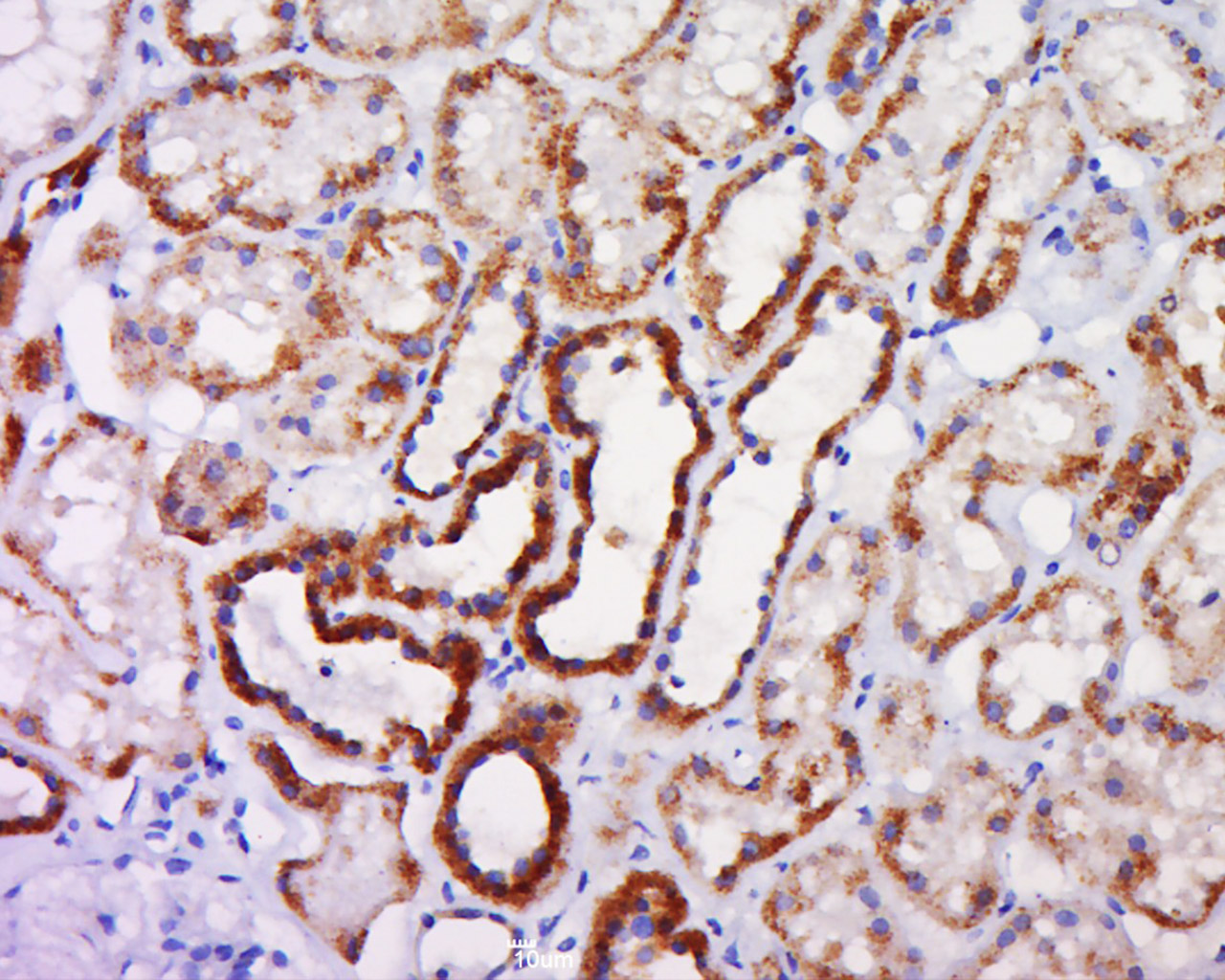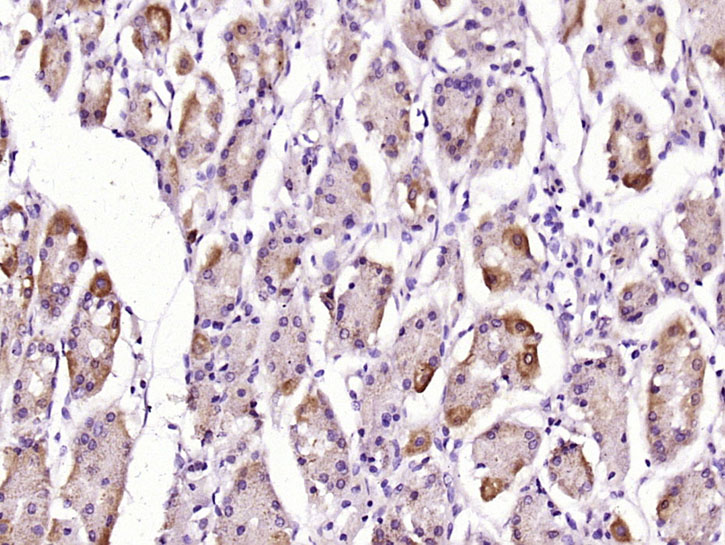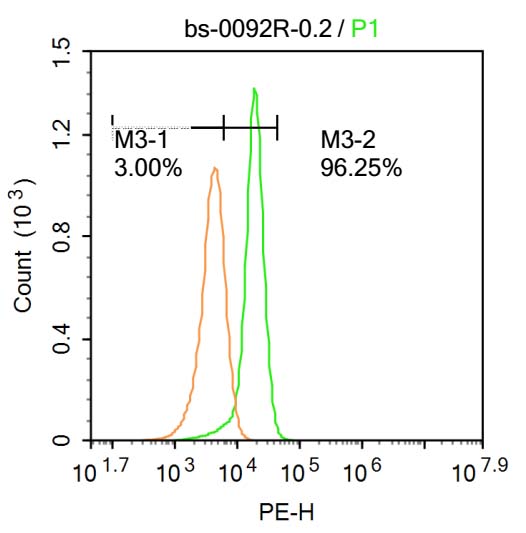
Rabbit Anti-Caspase-10 antibody
ALPS 2; ALPS2; Apoptosis related cysteine peptidase; Apoptotic protease Mch 4; CASP 10; CASP10; CASP10 protein; Caspase 10 apoptosis related cysteine peptidase; Caspase 10 apoptosis related cysteine protease; Caspase10; FADD Like Ice 2; Fas Associated Dea
View History [Clear]
Details
Product Name Caspase-10 Chinese Name 半胱胺酸蛋白酶-10抗体 Alias ALPS 2; ALPS2; Apoptosis related cysteine peptidase; Apoptotic protease Mch 4; CASP 10; CASP10; CASP10 protein; Caspase 10 apoptosis related cysteine peptidase; Caspase 10 apoptosis related cysteine protease; Caspase10; FADD Like Ice 2; Fas Associated Death Domain Protein; FAS associated death domain protein interleukin 1B converting enzyme 2; FLICE 2; FLICE2; ICE Like Apoptotic Protease 4; Interleukin 1B Converting Enzyme 2; MCH 4; MCH4. Research Area Cell biology immunology Apoptosis Immunogen Species Rabbit Clonality Polyclonal React Species Human, Applications ELISA=1:5000-10000 IHC-P=1:100-500 IHC-F=1:100-500 Flow-Cyt=0.2ug/test IF=1:100-500 (Paraffin sections need antigen repair)
not yet tested in other applications.
optimal dilutions/concentrations should be determined by the end user.Theoretical molecular weight 59kDa Cellular localization cytoplasmic Form Liquid Concentration 1mg/ml immunogen KLH conjugated synthetic peptide derived from human Caspase-10 subunit p12: 431-521/521 Lsotype IgG Purification affinity purified by Protein A Buffer Solution 0.01M TBS(pH7.4) with 1% BSA, 0.03% Proclin300 and 50% Glycerol. Storage Shipped at 4℃. Store at -20 °C for one year. Avoid repeated freeze/thaw cycles. Attention This product as supplied is intended for research use only, not for use in human, therapeutic or diagnostic applications. PubMed PubMed Product Detail Caspases are a family of intracellular proteases that mediate cell death and are the principal effectors of apoptosis. Caspase 10 (Mch4, ICE-LAP4, FLICE2) plays an important role in apoptosis induced by a variety of inducers such as TNF alpha and Anti-Fas antibody. It is a large prodomain caspase classified together with caspases 2, 8, and 9 as a signaling caspase. Four isoforms of caspase 10 (caspase 10a, 10b, 10c, and 10d) having the same prodomain but different mature large and small subdomain, have been described. Caspase 10 contains two death domains (DED) involved in linking to the death effector domain of the adapter protein FADD and recruiting the complex to TNFR1 and Fas. The inactive procaspase 10 is variably expressed in many tissues and cell lines as a cytosolic protein. The mature form of caspase 10 comprises two subunits, p23/p17 (splice isoforms) and p12. Interestingly, a caspase 9- dependent processing of caspase 10 by caspase 6 in cell-free extracts has recently been suggested. Caspase 10 can cleave and activate caspases 3, 4, 6, 7, 8, and 9. This is followed by cleavage of numerous key proteins, including the nuclear protein PARP.
Function:
Involved in the activation cascade of caspases responsible for apoptosis execution. Recruited to both Fas- and TNFR-1 receptors in a FADD dependent manner. May participate in the granzyme B apoptotic pathways. Cleaves and activates caspase-3, -4, -6, -7, -8, and -9. Hydrolyzes the small- molecule substrates, Tyr-Val-Ala-Asp-|-AMC and Asp-Glu-Val-Asp-|-AMC.
Subunit:
Heterotetramer that consists of two anti-parallel arranged heterodimers, each one formed by a 23/17 kDa (p23/17) (depending on the splicing events) and a 12 kDa (p12) subunit (By similarity). Self-associates. Interacts with FADD and CASP8. Found in a Fas signaling complex consisting of FAS, FADD, CASP8 and CASP10.
Tissue Specificity:
Detectable in most tissues. Lowest expression is seen in brain, kidney, prostate, testis and colon.
Post-translational modifications:
Cleavage by granzyme B and autocatalytic activity generate the two active subunits.
Phosphorylated upon DNA damage, probably by ATM or ATR.
DISEASE:
Defects in CASP10 are the cause of autoimmune lymphoproliferative syndrome type 2A (ALPS2A) [MIM:603909]. ALPS2 is characterized by abnormal lymphocyte and dendritic cell homeostasis and immune regulatory defects.
Defects in CASP10 are a cause of familial non-Hodgkin lymphoma (NHL) [MIM:605027]. NHL is a cancer that starts in cells of the lymph system, which is part of the body's immune system. NHLs can occur at any age and are often marked by enlarged lymph nodes, fever and weight loss.
Similarity:
Belongs to the peptidase C14A family.
Contains 2 DED (death effector) domains.
SWISS:
Q92851
Gene ID:
843
Database links:Entrez Gene: 843 Human
Omim: 601762 Human
SwissProt: Q92851 Human
Unigene: 5353 Human
Product Picture
Antigen retrieval: citrate buffer ( 0.01M, pH 6.0 ), Boiling bathing for 15min; Block endogenous peroxidase by 3% Hydrogen peroxide for 30min; Blocking buffer (normal goat serum,C-0005) at 37℃ for 20 min;
Incubation: Anti-Caspase-10 Polyclonal Antibody, Unconjugated(SL0092R) 1:500, overnight at 4°C, followed by conjugation to the secondary antibody(SP-0023) and DAB(C-0010) staining
Paraformaldehyde-fixed, paraffin embedded (Human stomach carcinoma); Antigen retrieval by boiling in sodium citrate buffer (pH6.0) for 15min; Block endogenous peroxidase by 3% hydrogen peroxide for 20 minutes; Blocking buffer (normal goat serum) at 37°C for 30min; Antibody incubation with (Caspase-10) Polyclonal Antibody, Unconjugated (SL0092R) at 1:400 overnight at 4°C, followed by operating according to SP Kit(Rabbit) (sp-0023) instructionsand DAB staining.Blank control:Molt-4.
Primary Antibody (green line): Rabbit Anti-Caspase-10 antibody (SL0092R)
Dilution: 0.2μg /10^6 cells;
Isotype Control Antibody (orange line): Rabbit IgG .
Secondary Antibody : Goat anti-rabbit IgG-PE
Dilution: 0.2μg /test.
Protocol
The cells were fixed with 4% PFA (10min at room temperature)and then permeabilized with 20% PBST for 20 min at-20℃. The cells were then incubated in 5%BSA to block non-specific protein-protein interactions for 30 min at at room temperature .Cells stained with Primary Antibody for 30 min at room temperature. The secondary antibody used for 40 min at room temperature. Acquisition of 20,000 events was performed.
Partial purchase records(bought amounts latest0)
No one bought this product
User Comment(Total0User Comment Num)
- No comment





 +86 571 56623320
+86 571 56623320




